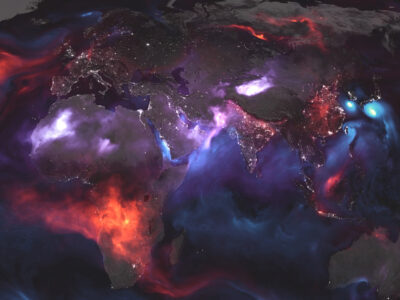By Aiko Voigt
Most rainfall occurs in the tropics, where it is concentrated in a band circling the Earth near the equator (see Fig. 1). Understanding how this rain band and its local constituents, i.e. the monsoon systems over land and the intertropical convergence zone over the ocean, will respond to climate change is one of the most stubborn questions in climate science (Bony et al., 2015; Voigt and Shaw, 2015). It is also one that has important implications for climate adaption. For example, because the rain band is so localized, small changes in its position can lead to large local rainfall changes.
Michela Biasutti and I organized a workshop at Columbia University last week to help answer this question. Tropical rainfall involves space and time scales from kilometers to continents, and from hours to millennia, so the workshop encompassed contributions about long-term past and future rainfall changes, conceptual frameworks and theories, and fast convective processes.

For me the most exciting lesson came from Earth’s past. Records of lake levels and decidious trees show that North Africa experienced a substantial increase in precipitation during the mid-Holocene (6,000 years ago), leading to a literally green Sahara. The rainfall increase was driven by changes in Earth’s orbit that led to increased sunlight in North Africa during summer.
Yet, when climate models are asked to simulate the mid-Holocene, they all fail to produce a strong enough increase in North African rainfall in the latitude band from 20 to 30 degrees N. While the records show an increase in rainfall by at least 200mm per year, no model simulates more than a 50mm per year increase (Harrison et al., 2015). This suggests that some fundamental process is misrepresented in all models.
The discussions at the workshop suggested that the daily cycle of rainfall over land might be such a process. Climate models rain too early, at noon instead of in the afternoon, and this bias can imprint on longer time scales (see this State of the Planet blog post).
The issue of combining time scales also came out in two other ways. First, we have a framework that relates north-south shifts of the tropical rain band to how much energy is pushed across the equator by the atmospheric circulation (Kang et al., 2009; Schneider et al., 2014). This framework has become very popular in recent years and was, for example, used to understand the impact of sulfate aerosols (Hwang et al., 2013) and clouds (Voigt et al., 2014) on tropical rainfall. The framework yields a quantitative relation between the rainfall shift on the one hand and the energy transport on the other hand.
In his talk, Aaron Donhoe argued that the same quantitative relation holds for short-term rainfall shifts that occur over the course of the seasonal cycle and long-term shifts that have occurred over the last couple of millennia and are expected to occur in the future. This implies that seasonal rainfall changes, for which we have good observations, can help to understand past and future rainfall changes, which are known less well.
Second, there is a line of climate science that attempts to use past changes as an analogue for future changes. This “past to future” approach is adapted in a new modeling activity that I presented at the workshop and that I am leading together with Michela Biasutti and Jack Scheff. We are comparing experiments with 14 global climate models and look at how the models respond when we increase CO2, representing global warming, versus when we change the sunlight similar to what happened 6,000 years ago in the mid-Holocene. These experiments, which we refer to as “Tropical Rain belts with an Annual Cycle and a Continent Model Intercomparison Project (TRAC-MIP),” will allow us to study to what extent mechanisms of past rainfall changes are relevant to future changes. We hope that this will help to clarify how model problems in simulating the mid-Holocene imprint on projections of future changes.
Aiko Voigt is an associate research scientist at the Lamont-Doherty Earth Observatory. He studies how clouds couple with the large-scale atmosphere circulation in both the mid-latitudes and the tropics. He co-organized the tropical rainfall workshop.



